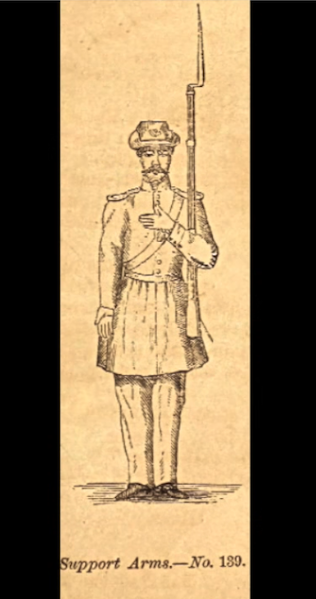3218 words
CHAPTER OR STORY 21 – TRAINED AT CAMP CASEY & A “LINCOLN MOMENT” https://www.youtube.com/watch?v=4LJpJeIwFMw#t=1h29m00s Click Here and the link will take you to the beginning of this story at 1:29:00 within the longer video called “Jasper Thompson’s Destiny Day September6, 1906”
FLICKR 31 photos
https://www.flickr.com/photos/jimsurkamp/albums/72157681950935236
With support from American Public University System (apus.edu). The sentiments expressed do not in any way reflect modern-day policies of APUS, and are intended to encourage fact-based exchange for a better understanding of our nation’s foundational values.

SOURCES AND IMAGE CREDITS & LINKS ARE LISTED FOLLOWING THE NARRATIVE
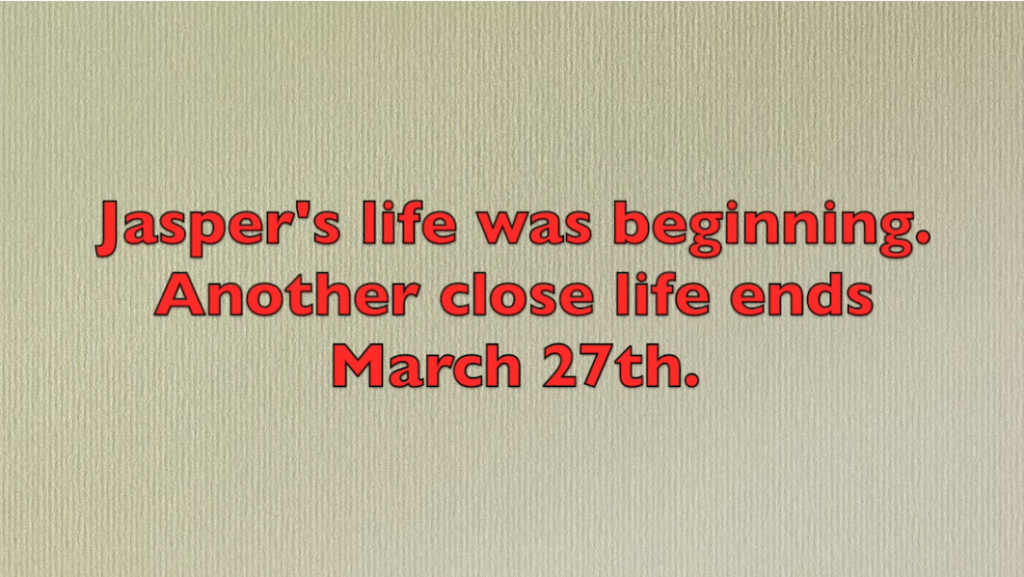
It’s hard to tell if Jasper knew, as he touched the ground at Camp Casey
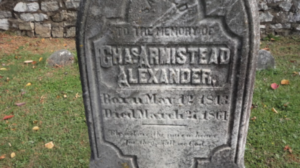

that 20-year-old Charles Armistead Alexander – a Washington family member Jasper probably knew quite well – had died two days before on March 27th at Blakeley and had been buried in the churchyard of Zion Church.
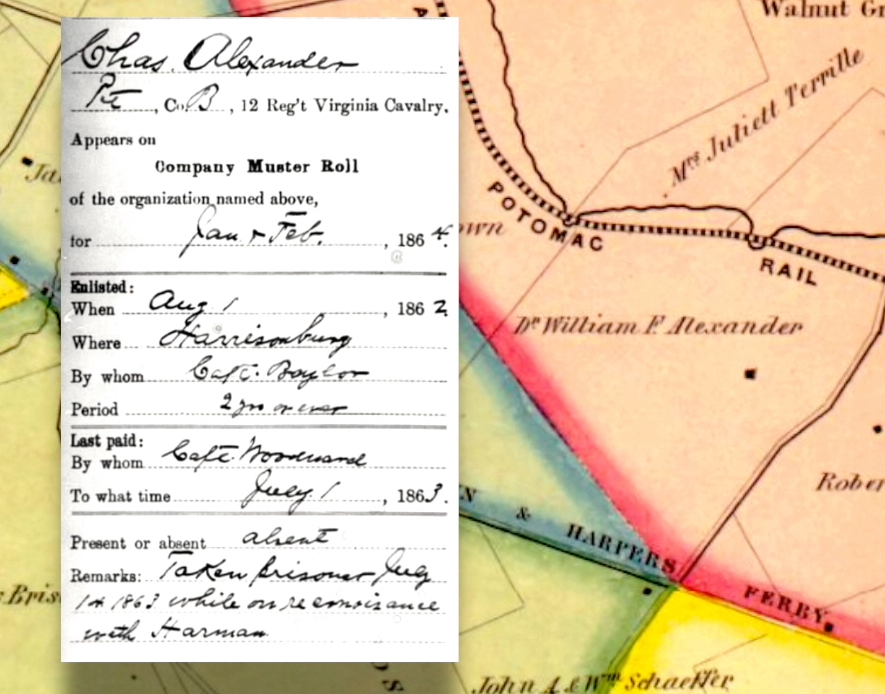
Captured the previous July while on a cavalry reconnaissance very near where both Charles and Jasper grew up at Walnut Hill Farm.
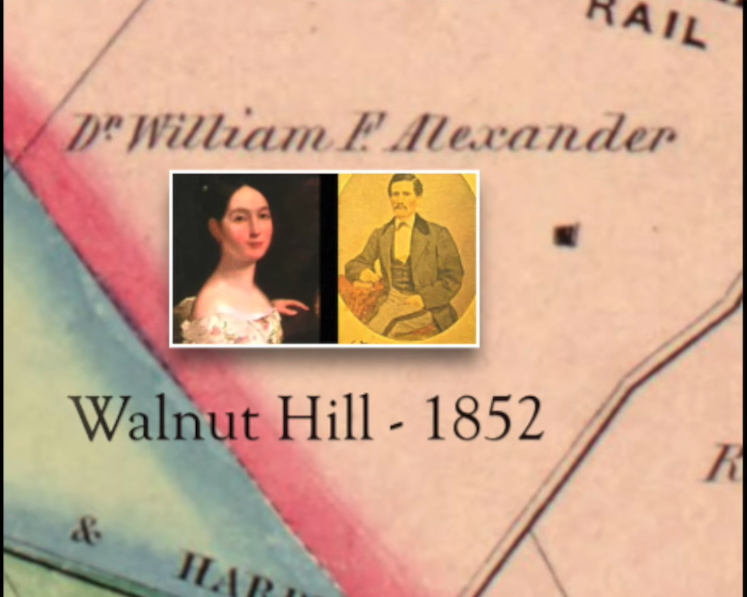

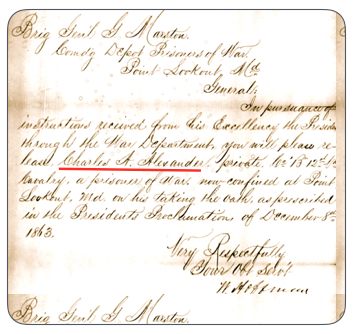
Charles was shuttled among three Federal hospitals as the family’s age-old nemesis – tuberculosis – overtook his weakened frame.
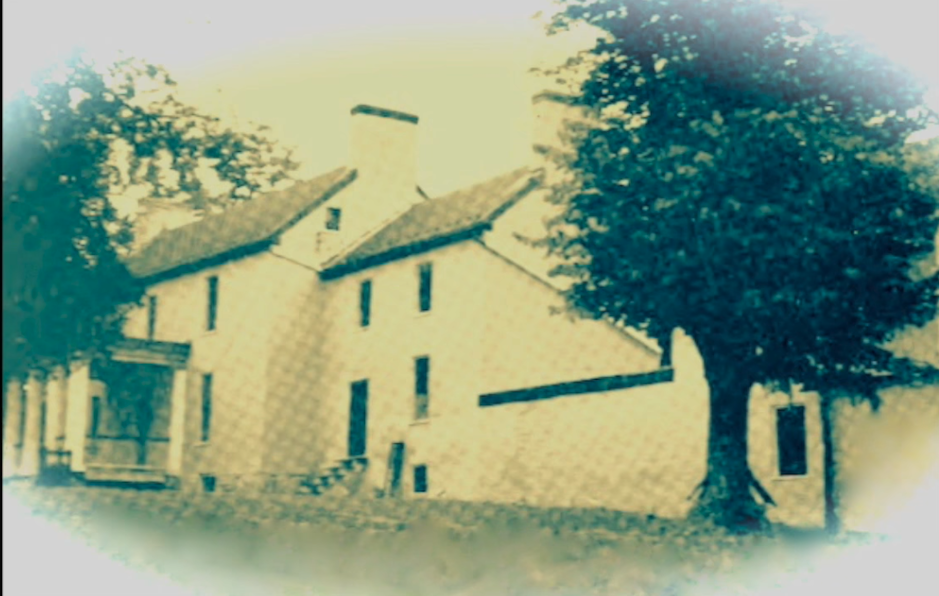
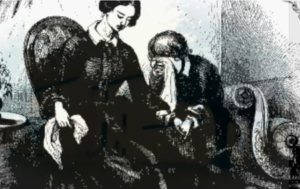
The family obtained his release just in time for the Christmas sojourn at Blakeley in 1863.



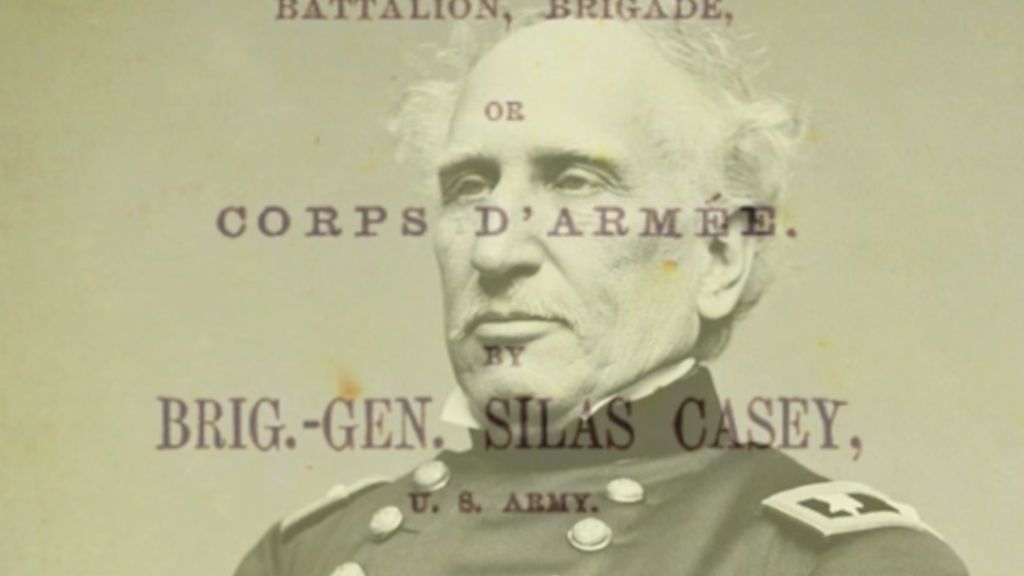

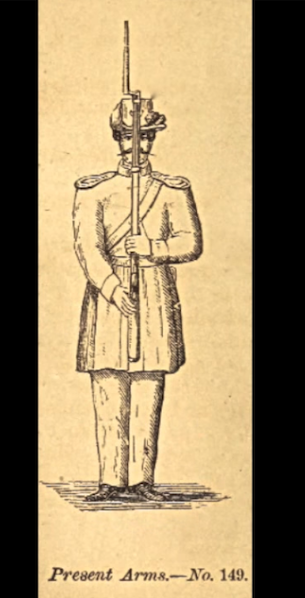
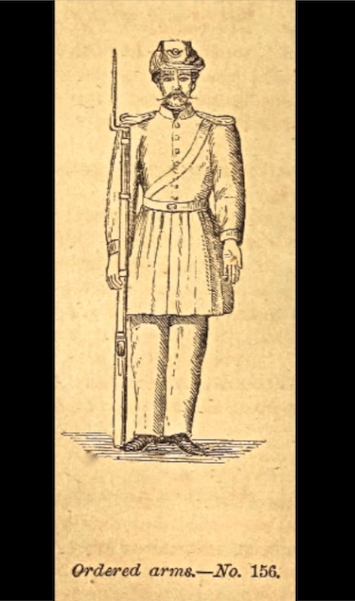
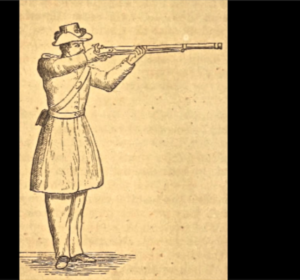




Artist Francis B. Carpenter recalled:
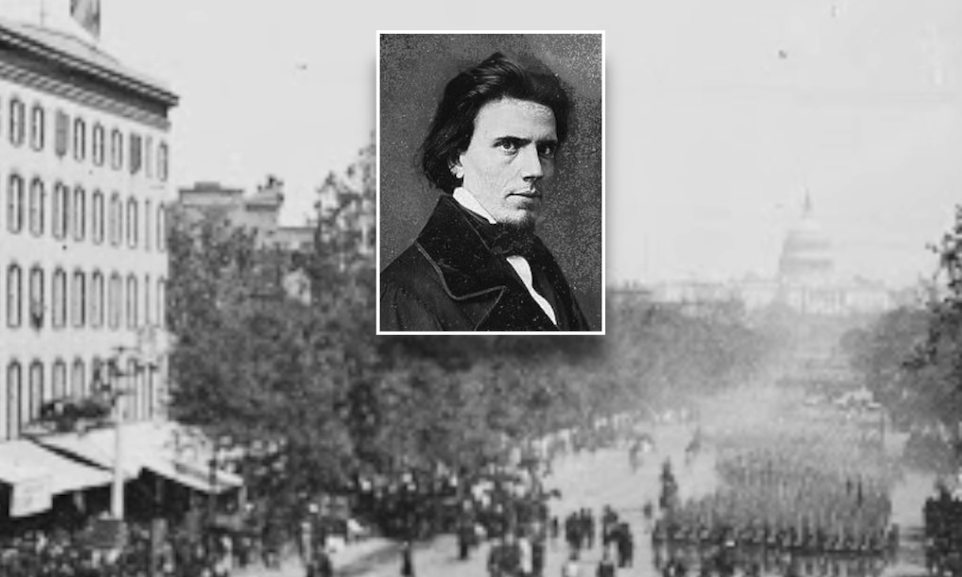
The 25th of April, Burnside’s command marched through Washington, on the way from Annapolis, to reinforce the army of the Potomac. The President reviewed the troops from the top of the eastern portico at Willard’s Hotel, standing with uncovered head while the entire thirty thousand men filed through Fourteenth Street. Of course the passage of so large a body of troops through the city — presaging as it did the opening of the campaign — drew out a numerous concourse of spectators, and the coming movement was everywhere the absorbing topic of conversation.
The last to march by Willard’s Hotel were the black troops, the first that Lincoln had ever formally reviewed. Charles Coffin, a reporter for the Boston Journal, described the moment as one of “sublime spectacle. “

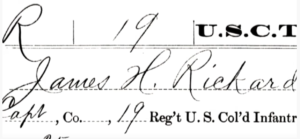
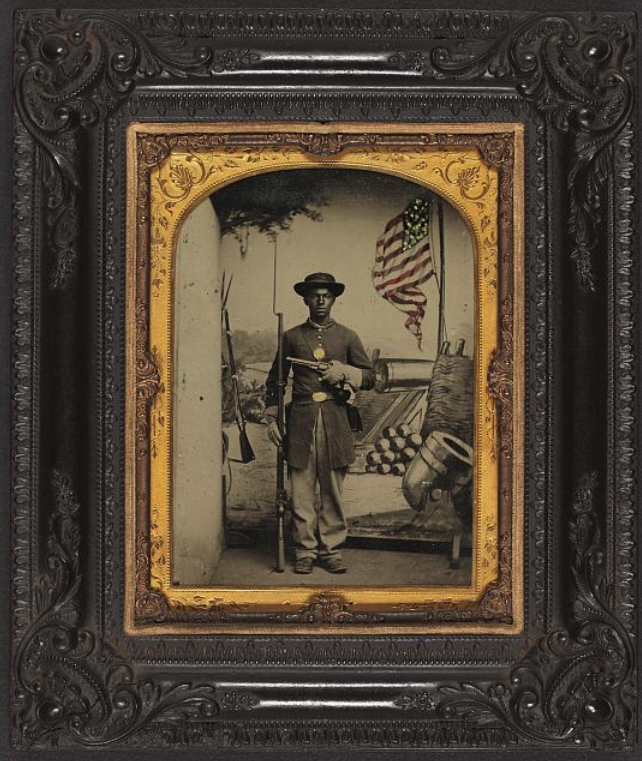
Captain James H. Rickard of the 19th U.S. Colored Troops later wrote: – “From Annapolis we marched to Washington. When we arrived at the outskirts of the city we halted, and after an hour of busy work, had removed most of the mud, brasses were polished and shoes blacked,
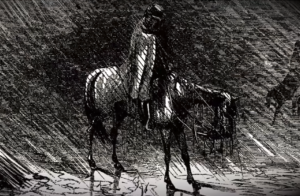
so that notwithstanding it had rained hard most of the way from Annapolis,
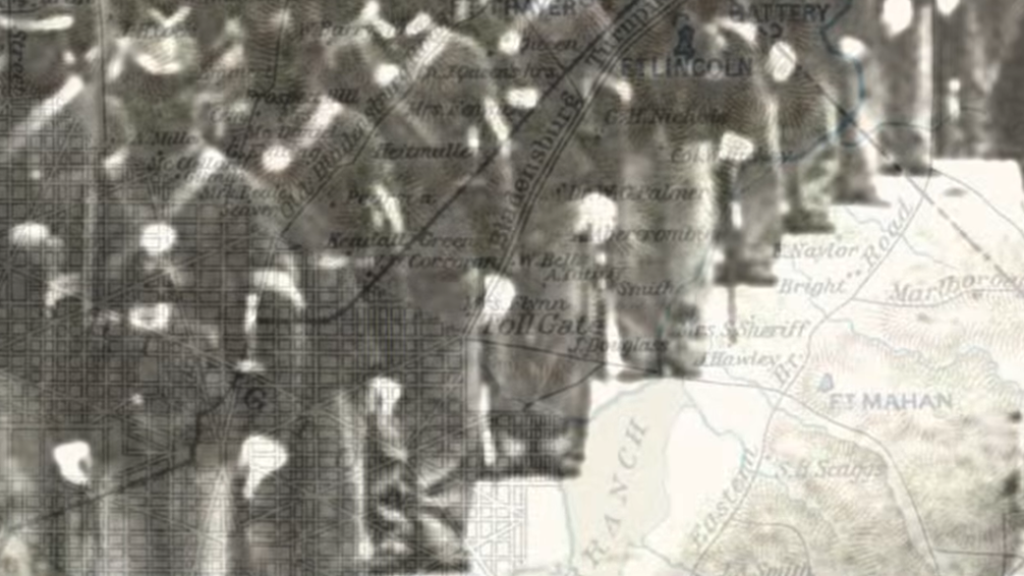

we made quite a presentable appearance. We now passed through the city in column, and were reviewed by President Lincoln and General Burnside.”


books.google.com
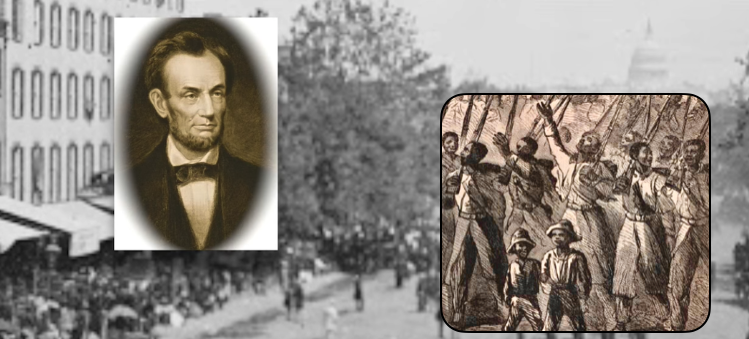
Charles Coffin reported:
Upon seeing Lincoln their Emancipator gazing down upon them, the Colored soldiers lapsed – “swinging their caps, clapping their hands and shout their joy – long loud and jubilant are the rejoicing of these redeemed sons of Africa.”
THAT EVENING AT THE WHITE HOUSE
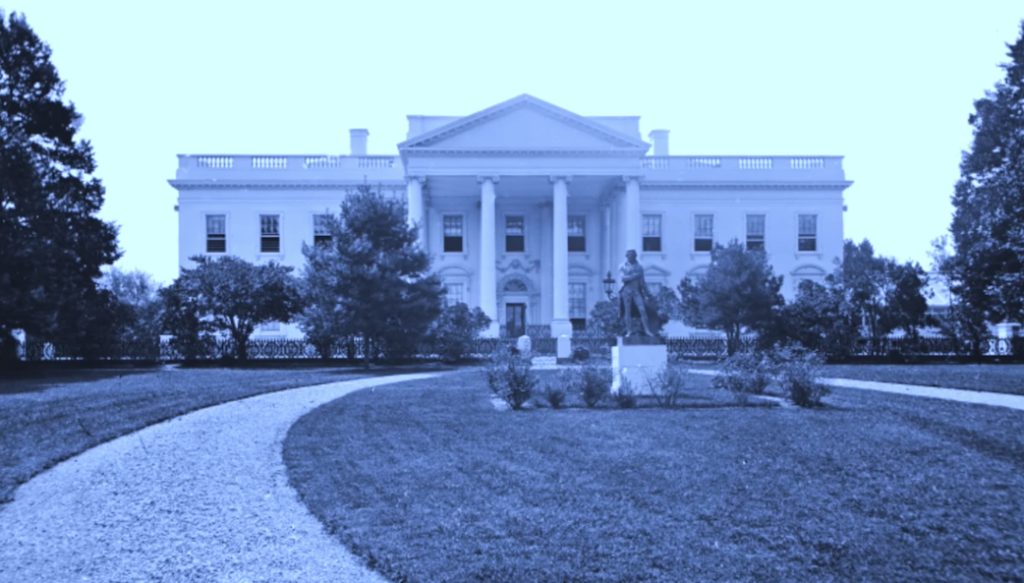

Description of the uses of rooms in the Lincoln White House.
There were seven bedrooms on the second floor of the White House where the office of the President was also located. Mr. and Mrs. Lincoln each occupied one. Lincoln’s secretaries, John Nicolay and John Hay, occupied another one. After Willie died, only Tad needed a bedroom on a regular basis and he often slept with his father. Robert occupied one of three guest bedrooms when he was home from college. So, there was always room for relatives and old friends, whom Mr. and Mrs. Lincoln often encouraged to stay with them – mrlincolnswhitehouse.org
The Queen’s Bedroom is located across the hall from the Lincoln Bedroom on the second floor of the White House. The room received its name from the various royal guests, such as Queen Elizabeth II, that have stayed in the room. In prior administrations the room was used as a bedroom for private secretaries and the children of the President, the room was previously known as the Rose Room. Currently the Queen’s Bedroom is furnished in the Federal style with a bed that once belonged to President Andrew Jackson. – theenchantedmanor.com


Later that evening at the White House, Carpenter recalled Lincoln’s reflections on the day:
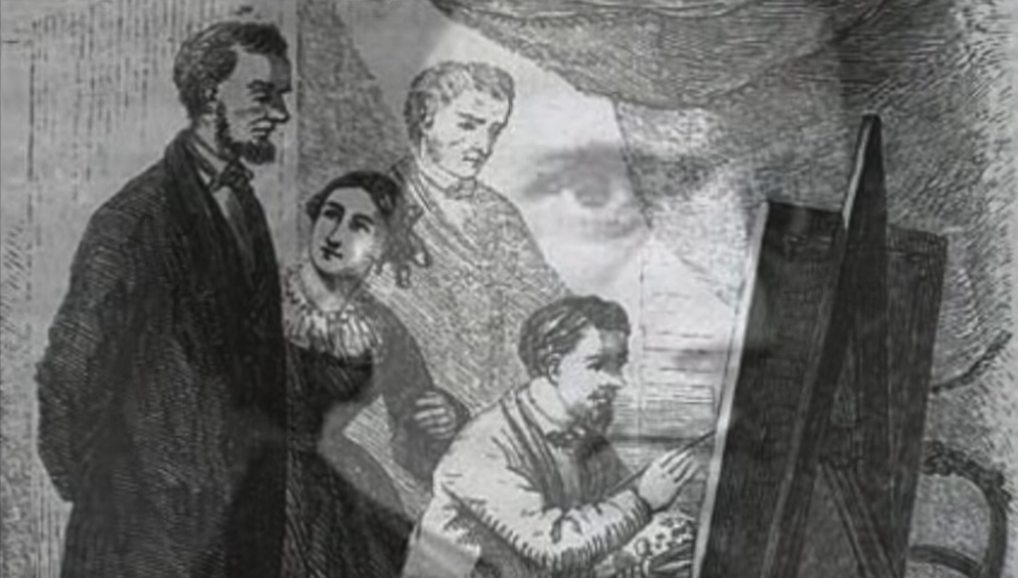
“Subsequently two gentlemen proposed to visit my room, and Mr. Lincoln accompanied them to see the painting I was working on.
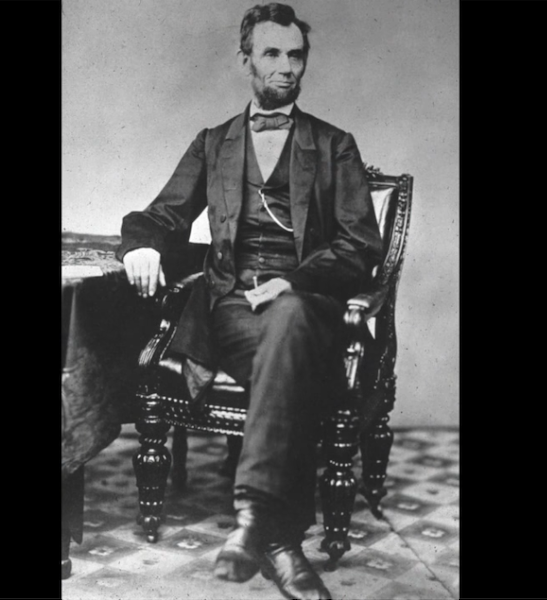
“Sitting down under the chandelier on the edge of the long table, which ran the whole length of the apartment, swinging back and forth his long legs, passing his hand occasionally over his brow and through his rough hair (his appearance and manner come back to me most vividly, as I write), he listened abstractedly to my brief explanation of the design of the picture.”
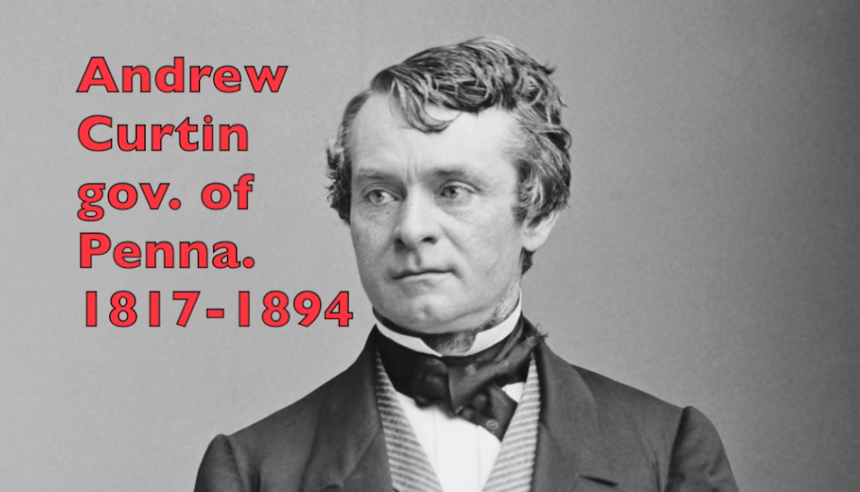
“When I ceased, he (Lincoln) took up the record in his own way, referring to one of the gentlemen: ‘You see, Curtin,” said he, “I was brought to the conclusion that there was no dodging this negro question any longer. We had reached the point where it seemed that we must avail ourselves of this element, or in all probability go under.’”

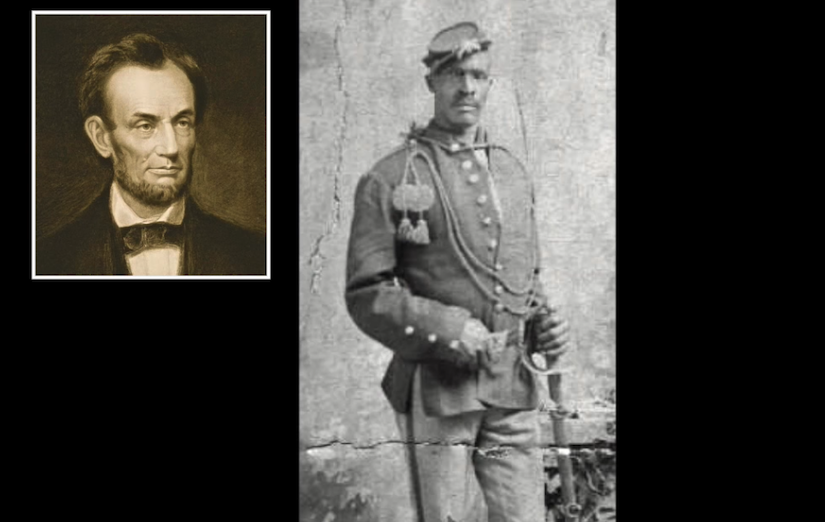

REFERENCES: (and IMAGE CREDITS)
Jasper Thompson’s service records
fold3.com 16 September 2011 Web 20 February 2017
Charles A. Alexander’s service records
fold3.com 16 September 2011 Web 20 February 2017
C. A. Alexander Service record taken from the 2nd Virginia Infantry Regiment by Dennis Frye Lynchburg, Va: Howard, Inc.
C. A. Alexander Service record
civilwarscholars.com 11 June 2011 Web. 20 February 2017.
Title Surveys for Military Defenses Map of Northeastern Virginia and Vicinity of Washington
Creator: Young, J. J. ; Hesselbach, W.
Publication Info: Washington: Government Printing Office http://digitalcollections.baylor.edu/cdm/singleitem/collection/tx-wotr/id/2067/rec/6
Google Maps location of Camp Casey west of the Pentagon bordered by Glebe Road-2nd Street South-Fillmore Street-7th Street South. https://www.google.com/maps/place/Washington,+DC/@38.8724491,-77.0900922,17z/data=!4m2!3m1!1s0x89b7c6de5af6e45b:0xc2524522d4885d2a
Casey, Silas. (1862). “Infantry tactics, for the instruction, exercise, and manœuvres of the soldier, a company, line of skirmishers, battalion, brigade, or corps d’armée.” v.1. New York, NY: D. Van Nostrand. https://archive.org/details/infantrytacticsf01brig
Carpenter, Francis Bicknell. (1866). “Six months at the White House with Abraham Lincoln.” New York, NY: Hurd and Houghton. Internet Archives archive.org 26 January 1997 Web. 20 February 2017. pp. 81-84 https://archive.org/stream/sixmonthsatwhit02carpgoog#page/n89/mode/1up
Carpenter’s room where they gathered:
I had been engaged in the official chamber until quite late one evening, upon some pencil studies of accessories, necessary to introduce in my picture. The President, Mrs. Lincoln, and the Private Secretaries had gone to the opera, and for the time being I had undisturbed possession. Towards twelve o’clock I heard some persons enter the sleeping apartment occupied by Mr. Nicolay and Major Hay, which was directly opposite the room where I was sitting; p. 149. https://archive.org/stream/sixmonthsatwhit02carpgoog#page/n157/mode/1up
Willard Hotel Location on a Map today Google Maps https://www.google.com/maps/place/38°53’47.2″N+77°01’56.5″W/@38.89645,-77.03235,15z?hl=en
Hail to the Chief
wikipedia.org 27 July 2001 Web. 20 February 2017.
Rickard, James H. (1894) “Services with Colored Troops in Burnside’s Corps.”
from Personal Narratives of events in the War of the Rebellion, being papers read before the Rhode island Soldiers and Sailors Historical Society. Fifth Series – No. 1(1894). Providence, RI: The Providence Press. books.google.com 24 November 2005 Web. 20 February 2017.
pp.13-17 https://books.google.com/books?id=vqcyAQAAMAAJ&pg=PP10&focus=viewport&dq=inauthor%3A”James+H.+Rickard”&output=text Rickard’s account of the 19th U.S. Colored Troops in Annapolis, MD. then Washington D.C.:
About the 20th day of April, 1864, we were ordered to embark on boats and proceed to Annapolis, Md. The impression made by these troops was voiced as follows by the Baltimore American the day of our departure: ” The three regiments of colored troops recruited in this city and State, nearly three thousand men, under the auspices of Colonel Bowman, made a dress parade through our streets this morning previous to their departure for the scene of—it is to be hoped—active operations. No man desiring the speedy overthrow of the rebellion, and its proper termination, could have looked upon the spectacle with other than feelings of satisfaction. Only one of the regiments was armed (the Nineteenth), the other two were fully equipped except arms. A splendid brass band was on the right of the line, and a full drum corps accompanied each regiment. The men all marched proudly and soldierly, and nothing could have been more perfect than their movement, evidencing a great deal of care in their management and drill. Magnificent working and fighting material was in that column. Sturdy, stalwart, able-bodied and healthy men, well disciplined by careful training, proud of their new and novel position, they looked every inch the soldier.
A few years ago the man who would have said that the negro would have marched through the streets of Baltimore in military equipments and unarmed without being assaulted, would have been considered a fit candidate for a lunatic asylum. But such is the case, and during their march this morning it was pleasant to see, as the head of the column passed the Maryland Institute, where the arrangements for the fair are in progress, that they were lustily cheered. In many places along the route of march, flags were waved from the stateliest or from the humblest dwellings. Several of the men were accompanied to the point of embarkation, the foot of Long Dock, by their wives and sisters, and many were the leave-takings there witnessed. Some of the more rabid of the rebels in our midst gave vent to their spleen in silent murmurs and ‘curses not loud but deep.’ One female, who was standing at the Institute as the procession turned down the market space, thought it had come to a pretty pass when she had to stand to allow ‘ni**ers’ to pass, and that they were a nice crowd to send to fight white men. But notwithstanding the grievances of the fair secesh, the troops passed quietly by, amid the congratulations of those who think the United States government can rightly use the colored man for a soldier or a laborer, as well as the rebel oligarchy at Richmond. May we have many more such regiments to credit to the quota of Maryland, as those that passed the American office this morning.”
From Annapolis we marched to Washington. When we arrived at the outskirts of the city we halted, and after an hour of busy work, had removed most of the mud, brasses were polished and shoes blacked, so that notwithstanding it had rained hard most of the way from Annapolis, we made quite a presentable appearance.
We now passed through the city in column, and were reviewed by President Lincoln and General Burnside from the steps of WiIlard’s Hotel. Accoutered, as we were, with a full complement of clothing, etc., and the day being very warm, the march from outside the city until across Long Bridge, without a stop and with cadenced step, was very trying, but not a man left the ranks until the bridge was passed. We now found we were to join the Ninth Corps, which was marching to join the Army of the Potomac. We arrived at the Rapidan River on the morning of the first day’s fight in the Wilderness. We immediately crossed a pontoon bridge and relieved a part of the Sixth Corps, who had been heavily engaged. Our position was now on the extreme right of the Army of the Potomac, just above Germanna Ford, where we and all the army crossed, and that night our regiment was on the picket line with the rebs in sight in our front. About two o’clock the next morning the Ninth Corps was ordered to fall back and move to the left; the aide, with the orders for our division, either lost his Way or for some other reason, did not reach us until after the time we were to move ; orders then had to be sent to the different brigades and by them to the regiments, and the pickets withdrawn, which took some time. Before we could move the three other divisions had fallen back and moved to the left, leaving us entirely out off. It was a race for life as we moved down that plank road through the thick pine forest, and the enemy trying to cut us off, but we passed behind the right of our army, which was being thrown back to the river much lower down.
Title: Map of the Ground of Occupation and Defense of the Division of the U.S Army in Virginia
Other Title: Defenses of Washington
Publication Info: Washington: Government Printing Office
Physical Description 1 map: col.
Plate No. 6
Map No. 1
Scale 1 : 31,680
Resource Type: Map
Date: 1861/06/01 – 1861/07/31
Publication Date: 1891
Coverage – Date Range 1861-1865
City/Towns: Alexandria ; Georgetown ; Washington ; Uniontown http://digitalcollections.baylor.edu/cdm/singleitem/collection/tx-wotr/id/2051/rec/2
Title: Central Virginia showing Lieut. Gen. U.S. Grant’s Campaign and Marches of the Armies under his Command in 1864-1865. Engineer Bureau, War Dept.
Publication Info: Washington : Government Printing Office
Physical Description: 1 map :col.
Plate No.: 100
Map No. 1
Resource Type: Map
Publication Date: 1891
Coverage – Date Range: 1861-1865 http://digitalcollections.baylor.edu/cdm/singleitem/collection/tx-wotr/id/1353/rec/1
James H. Rickard Captain 19th USCT Service Record p. 5
fold3.com 16 September 2011 Web 20 February 2017
They swing their caps, clap their hands and shout their joy Long loud and jubilant are the rejoicings of these redeemed sons of Africa. – Charles Coffin The Boston Journal as quoted in
books.google.com 24 November 2005 Web. 20 February 2017.
Trudeau, Noah A. “A Stranger in the Club: The Army of the Potomac’s Black Division.” Chapter 5 in Boritt, Gabor S. (2007).”Slavery, Resistance, Freedom.” New York, NY, London, UK: Oxford University Press Co.
There were seven bedrooms on the second floor of the White House where the office of the President was also located. Mr. and Mrs. Lincoln each occupied one. Lincoln’s secretaries, John Nicolay and John Hay, occupied another one. After Willie died, only Tad needed a bedroom on a regular basis and he often slept with his father. Robert occupied one of three guest bedrooms when he was home from college. So, there was always room for relatives and old friends, whom Mr. and Mrs. Lincoln often encouraged to stay with them. http://www.mrlincolnswhitehouse.org/residents-visitors/relatives-and-residents/
The Queen’s Bedroom is located across the hall from the Lincoln Bedroom on the second floor of the White House. The room received its name from the various royal guests, such as Queen Elizabeth II, that have stayed in the room. In prior administrations the room was used as a bedroom for private secretaries and the children of the President, the room was previously known as the Rose Room. Currently the Queen’s Bedroom is furnished in the Federal style with a bed that once belonged to President Andrew Jackson. http://theenchantedmanor.com/tag/white-house-second-floor-plan/
Hay’s office is today known as the Queens’ Sitting Room; the bedroom he shared with Nicolay is known as the Queens’ Bedroom. See Zeitz 2014a, p. 87.
Zeitz, Joshua (2014). Lincoln’s Boys: John Hay, John Nicolay, and the War for Lincoln’s Image (Kindle ed.). New York: Viking Penguin. ISBN 978-1-101-63807-1.
wikipedia.org 27 July 2001 Web. 20 February 2017.
POST: 27 “Sacrificers” by Jim Surkamp. 1098 words.
civilwarscholars.com 11 June 2011 Web. 20 February 2017.
IMAGE CREDITS:
Zion Episcopal Church
zionepiscopal.net 19 July 2008 Web. 20 February 2017.
Letter confirming C. A. Alexander’s oath of allegiance and release on Dec. 23, 1863
fold3.com 16 September 2011 Web 20 February 2017
Tombstone of Charles A. Alexander by Monte Harding
findagrave.com 5 December 1998 web. 20 February 2017.
Wayland, John W. (1944). “The Washingtons and their Homes.” McClure Printing Company: Staunton, VA. hathitrust.org 26 August 2015 Web. 20 September 2016.
p. 226 – Blakeley.
Strother, David H., “Personal Recollections of the Civil War.” Harper’s New Monthly Magazine. New York, NY: Harper and Bros. Volume 34, Issue: 200, January, 1867. hathitrust.org
Strother, David H., “Personal Recollections of the Civil War.” Harper’s New Monthly Magazine. New York, NY: Harper and Bros. Volume 34, Issue: 200, January, 1867. hathitrust.org
p. 190 After the battle (two women sitting, one grieving, one comforting). https://babel.hathitrust.org/cgi/pt?id=uc1.31210012370779&view=1up&seq=203&skin=2021
Walnut Hill from
Title: Map of Jefferson County, Virginia
Summary: Shows Jefferson County before the formation of West Virginia in 1863.
Contributor Names: Brown, S. Howell. Created / Published: [S.l., s.n.,] 1852.
loc.gov 16 June 1997 Web. 20 February 2017. https://babel.hathitrust.org/cgi/pt?id=uc1.31210012370779&view=1up&seq=203&skin=2021
Title: Point Lookout, Md. View of Hammond Genl. Hospital & U.S. genl. depot for prisoners of war
Contributor Names: Everett, George (Publisher). Created / Published: Point Lookout 1864.
loc.gov 16 June 1997 Web. 20 February 2017.
Title: A map of the Baltimore & Ohio Railroad and its principal connecting lines uniting all parts of the East & West.
Summary: Outline map of the eastern half of the United States to about the 95th Meridian. [From published bibliography]
Contributor Names: A. Hoen & Co. Created / Published: Baltimore, Lith. by A. Hoen & Co. [1860]
loc.gov 16 June 1997 Web. 20 February 2017.
NOT USED
Opening of the Wilderness by Thomas Rossiter about 1857-1859
Credit Line
Bequest of Martha C. Karolik for the M. and M. Karolik Collection of American Paintings, 1815-1865
mfa.org 20 December 1996 Web. 20 February 2017.
Station on the Morris and Essex Railroad
Edward Lamson Henry – 1864 https://gallerix.org/storeroom/1844945966/N/1980614078/
NOT USED
Title: Camp Casey, near Bladensburg, Md. / lith. by E. Sachse & Co., Baltimore, Md.
Summary: Camp Casey showing 4th Regt. R.I.V. Col. J.P. Radman, 5th Regt. N.H.V. Col. Edward Cross, and Fort Lincoln in background.
Contributor Names: E. Sachse & Co., lithographer. Created / Published: c1861.
loc.gov 16 June 1997 Web. 20 February 2017.
Lithograph of Camp Casey according to Chelsea Gilmour
consortiumnews.com 11 November 1998 Web. 20 February 2017.
Silas Casey
wikipedia.org 27 July 2001 Web. 20 February 2017.
Casey, Silas. (1862). “Infantry tactics, for the instruction, exercise, and manœuvres of the soldier, a company, line of skirmishers, battalion, brigade, or corps d’armée.” v.1. New York, NY: D. Van Nostrand. Internet Archives archive.org 26 January 1997 Web. 20 February 2017.
title page
p. 34 – shouldered arms
p. 39 – Support arms
p. 39 – Present arms
p. 40 – Ordered arms
p. 46 – Aim
Title: Washington, District of Columbia. Grand review of the army
Creator(s): Brady, Mathew B., ca. 1823-1896, photographer
Date Created/Published: 1865 May.
Medium: 1 negative (2 plates) : glass, stereograph, wet collodion.
loc.gov 16 June 1997 Web. 20 February 2017.
Abraham Lincoln is a painting by Francis Bicknell Carpenter which was uploaded on May 22nd, 2014.
fineartamerica.com 11 November 1998 Web. 20 February 2017.
Francis Bicknell Carpenter
wikipedia.org 27 July 2001 Web. 20 February 2017.
Image: Detail from – [Unidentified African American soldier in Union sergeant uniform holding a rifle] Date Created/Published: [between 1863 and 1865] Medium: 1 photograph : sixth-plate tintype, hand-colored ; 12.3 x 11.2 cm (frame).
loc.gov 16 June 1997 Web. 20 February 2017.
Strother, David H., “Personal Recollections of the Civil War.” Harper’s New Monthly Magazine. New York, NY: Harper and Bros. Volume 35, Issue: 207, August, 1867. hathitrust.org https://babel.hathitrust.org/cgi/pt?id=mdp.39015056090429&view=1up&seq=300&skin=2021
p. 288 – in the rain
Image: Detail from [Unidentified African American soldier in Union uniform with a rifle and revolver in front of painted backdrop showing weapons and American flag at Benton Barracks, Saint Louis, Missouri] at attention small rimmed hat straight ahead medium build flag. Creator(s): Long, Enoch, 1823-1898, photographer. Date Created/Published: [between 1863 and 1865]. Medium: 1 photograph : quarter plate tintype, hand-colored ; 16.2 x 13.6 cm. (frame).
loc.gov 16 June 1997 Web. 20 February 2017.
NOT USED
Image: City Point, Virginia. Negro soldier guarding 12-pdr. Napoleon. (Model 1857?) Date Created/Published: [1865]
Medium: 1 negative (2 plates) : glass, stereograph, wet collodion. Reproduction Number: LC-DIG-cwpb-01982 (digital file from original neg. of left half) LC-DIG-cwpb-01983 (digital file from original neg. of right half)
The 26th U.S. Colored Volunteer Infantry on parade, Camp William Penn, Pa., 1865. 165-C-692. National Archives Identifier: 533126.
archives.gov 31 March 2002 Web. 20 February 2017.
Title: English: Abraham Lincoln poses in Gardner’s new gallery. Imperial albumen print.
Description: English: Gardner took this portrait of Lincoln 8 November 1863, along with four other studies made during the same sitting.
Date: 8 November 1863
Medium: photograph
Dimensions 46.4 × 36.8 cm (18.3 × 14.5 in)
Object history Sold at auction by Sotheby’s for $98,500 USD on 05 October 2011.
Notes: Ostendorf# O-79; Meserve# M-58
Source/Photographer: Alexander Gardner (1821–1882) Link back to Creator infobox template wikidata:Q661176
wikipedia.org 27 July 2001 Web. 20 February 2017.
Abraham Lincoln on November 8, 1863. Eleven days before the Gettysburg Address.
civilwarprofiles.com 15 May 2013 Web. 20 February 2017.
http://www.civilwarprofiles.com/abraham-lincoln-smallpox-and-the-gettysburg-address/
The White House North Lawn in the 1860s, during the Abraham Lincoln administration
wikipedia.org 27 July 2001 Web. 20 February 2017.
Sentry on duty at the east gate on the north side of the White House, 1864
Library of Congress / White House Historical Association
kentucky.com 21 December 1997 Web. 20 February 2017.
White House & The Queen’s Bedroom
wikipedia.org 27 July 2001 Web. 20 February 2017.
Lincoln standing beside table in bedroom;
whitehousemuseum.org 25 June 2006 Web. 20 February 2017.
Abraham Lincoln in his office, circa 1863
whitehousemuseum.org 25 June 2006 Web. 20 February 2017.
viewing Carpenter at Work on the Picture
townofhomer.org 18 August 2013 Web. 20 February 2017.
Andrew Gregg Curtin
wikipedia.org 27 July 2001 Web. 20 February 2017.
Abraham Lincoln, c 1863. Known as the “big foot” photograph.
Lincoln in November, 1863, about to leave for Pennsylvania. The reason for his confident look may have been within the envelope lying on the table, believed to contain his draft of the Gettysburg Address
conservapedia.com 14 December 2006 Web. 10 February 2017.
Vieilles Annonces
Black Civil War Soldier
These photographs have one thing in common. They are all unknown. The only information known is what I’ve published here. If you know or think you know anything at all about the photographs, please comment on the photo. Thank you for your assistance.
flickr.com 26 February 2004 Web. 20 February 2017.


CHAPTER OR STORY 22 CLICK HERE https://civilwarscholars.com/uncategorized/chapter-22-manassas-camp-the-men-become-one-by-jim-surkamp/

